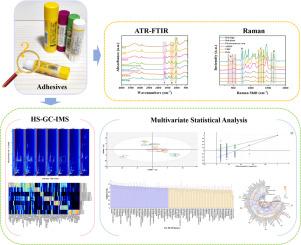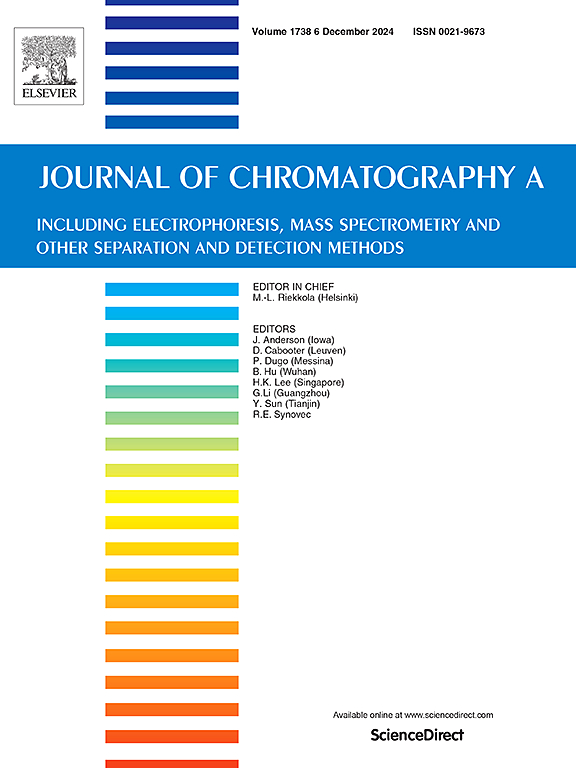Analysis and discrimination of adhesive species using ATR-FTIR combined with Raman, and HS-GC-IMS together with multivariate statistical analysis
IF 4
2区 化学
Q1 BIOCHEMICAL RESEARCH METHODS
引用次数: 0
Abstract
Identifying the species and origin of adhesives in criminal investigations aids in narrowing inquiry scope and supporting case detection. This study introduces two advanced combined analytical techniques for distinguishing adhesive species, including attenuated total reflectance-Fourier transform infrared spectroscopy (ATR-FTIR) combined with Raman spectroscopy, and headspace gas chromatography-ion mobility spectrometry (HS-GC-IMS) together with multivariate statistical analysis. ATR-FTIR categorized seven adhesives into three groups based on the base materials, with further differentiation achieved via Raman spectra. Analysis of volatile components identified 79 volatile organic compounds (VOCs), with esters being the most concentrated. The fingerprint profile clearly illustrated the characteristic fingerprint sequence and unique marker compounds of each adhesive, effectively enabling their differentiation. Multivariate statistical analysis methods, including principal component analysis (PCA), orthogonal partial least squares-discriminant analysis (OPLS-DA), heatmap, and hierarchical cluster analysis (HCA), were utilized to visually interpret the classification of adhesives. This integrated analytical approach provides a comprehensive analysis of adhesive compositions, facilitating the diversification and precision of adhesive species identification, and broadening the scope for detecting and analyzing trace evidence in forensic science.

利用 ATR-FTIR 结合拉曼、HS-GC-IMS 以及多元统计分析来分析和区分粘合剂种类。
在刑事调查中确定粘合剂的种类和来源有助于缩小调查范围和支持案件侦破。本研究介绍了两种用于区分粘合剂种类的先进组合分析技术,包括衰减全反射-傅立叶变换红外光谱(ATR-FTIR)与拉曼光谱相结合,以及顶空气相色谱-离子迁移谱(HS-GC-IMS)与多元统计分析相结合。ATR-FTIR 根据基底材料将七种粘合剂分为三组,并通过拉曼光谱进行进一步区分。挥发性成分分析确定了 79 种挥发性有机化合物 (VOC),其中酯类最为集中。指纹图谱清楚地显示了每种粘合剂的特征指纹序列和独特的标记化合物,从而有效地对它们进行了区分。利用多变量统计分析方法,包括主成分分析法(PCA)、正交偏最小二乘法-判别分析法(OPLS-DA)、热图和层次聚类分析法(HCA),直观地解释了粘合剂的分类。这种综合分析方法提供了对粘合剂成分的全面分析,促进了粘合剂种类鉴定的多样化和精确化,并拓宽了法医学中痕量证据的检测和分析范围。
本文章由计算机程序翻译,如有差异,请以英文原文为准。
求助全文
约1分钟内获得全文
求助全文
来源期刊

Journal of Chromatography A
化学-分析化学
CiteScore
7.90
自引率
14.60%
发文量
742
审稿时长
45 days
期刊介绍:
The Journal of Chromatography A provides a forum for the publication of original research and critical reviews on all aspects of fundamental and applied separation science. The scope of the journal includes chromatography and related techniques, electromigration techniques (e.g. electrophoresis, electrochromatography), hyphenated and other multi-dimensional techniques, sample preparation, and detection methods such as mass spectrometry. Contributions consist mainly of research papers dealing with the theory of separation methods, instrumental developments and analytical and preparative applications of general interest.
 求助内容:
求助内容: 应助结果提醒方式:
应助结果提醒方式:


